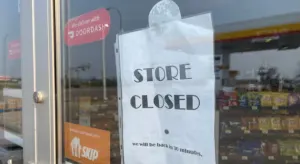
Ontario's carbon emissions jump back to pre-pandemic levels
New figures show Ontario's greenhouse gas emissions jumped for a second straight year, following a pandemic-induced plunge, and have risen back to the level they were before Premier Doug Ford's government came to power.
The figures come from the annual national inventory of emissions, which reveals sources of carbon dioxide (CO2) and other greenhouse gases across all provinces and all sectors, including industry, transportation and buildings.
SEE ALSO: Climate change damage could cost $38 trillion per year by 2050: Study
The report shows Ontario produced 157 megatonnes of carbon emissions in 2022. That's up 5.7 per cent from 2020, when pandemic restrictions triggered a sharp drop in commuting, and Ontario's greenhouse gas emissions dropped to the lowest level since tracking began in 1990.
Gideon Forman, climate change and transportation policy analyst for the David Suzuki Foundation, calls the increase worrisome.
"Right at the very moment when we're supposed to be reducing our emissions, they're going up in Ontario, and they're going up by millions of tonnes of carbon pollution," Forman said in an interview.

(Pixabay)
Ontario's 2022 emissions were nearly equivalent to the province's output of 158 megatonnes in 2017. That was the first year of the previous Liberal government's cap and trade program, which Ford's Progressive Conservatives scrapped just days after taking office.
The Ford government's current target is to reduce Ontario's annual emissions to 144 megatonnes by 2030.
"If Ontario continues on the trajectory it's currently on, we're not going to make our 2030 targets," said Forman.
CBC News asked for an interview Thursday with Environment Minister Andrea Khanjin, but officials said she was not available.
In an email, Khanjin's spokesperson Corey Michaels said the government's plan to reduce emissions is working.
"We'll continue building on this success by making Ontario a global leader in electric vehicles and investing in clean steel production, which will reduce emissions by the same amount as taking two million cars off the road," Michaels said.

Despite Premier Doug Ford's opposition to the federal carbon tax, Ontario does impose a carbon price on large industrial emitters. (Ed Middleton/CBC News)
The steel industry — with hundreds of millions of dollars in support from the federal and provincial governments — is aiming to switch from coal-fired to electric-powered furnaces, a move that is expected to be Ontario's biggest source of emission reductions this decade.
The report lists emissions from every major industrial facility in the country, and it shows the three biggest emitters in Ontario are steel plants.
ArcelorMittal Dofasco in Hamilton, Algoma Steel in Sault Ste. Marie and Stelco Inc.'s Lake Erie plant in Haldimand County accounted for 11.6 megatonnes of emissions collectively in 2022, the report showed.
"We've proven you can protect the environment without a costly, job-killing carbon tax," Michaels added in the emailed statement.
Ontario actually has a carbon tax of its own, imposed on the biggest industrial emitters.

(Pexels)
The clean-steel initiative, the industrial carbon tax and a mandate for greater renewable content in gasoline account for nearly all the expected emission reductions in the Ford government's plan for meeting its 2030 target.
Dave Sawyer, principal economist with the Canadian Climate Institute, a policy research organization, says there's some good news in the fact that Ontario's emission levels in 2022 were comparable to 2017, given that the province's economy and population grew during that time period.
"We've got a lot of technology that we're adopting that's driving down the [carbon] intensity of our activity," said Sawyer in an interview.
However, with Ontario's economy and population expected to keep growing, Sawyer is reluctant to predict whether Ontario will be able to cut its annual emissions by some 14 megatonnes over the next eight years.
"Whether we can hit targets or not really is an open question," he said.

Vehicles are responsible for more than one-quarter of all of Ontario's CO2 emissions, according to the latest figures. (Yvon Theriault/CBC)
Monica Curtis, senior director of the Pembina Institute, a clean energy think-tank, says Ontario risks losing ground in its emission reductions by increasing the use of gas-fired electricity production.
However, Curtis applauded the government's moves to attract electric vehicle plants to the province, which she called "a great first step" toward reducing transportation emissions.
The national report shows that road transportation accounted for 26 per cent of Ontario's greenhouse gas production in 2022.
Forman says some of the Ford government's key policies give people more incentive to drive, such as reducing the provincial gas tax and building Highway 413, which would run for more than 50 kilometres between Milton and the northern edge of Vaughan.
"If you're serious about reducing greenhouse gas emissions, you don't build a new 400-series highway through the Greenbelt," Forman said.
WATCH: How 'stratospheric dehydration' could help offset carbon emissions
Thumbnail courtesy of Evan Mitsui/CBC.
The story was originally written by Mike Crawley and published for CBC News.










